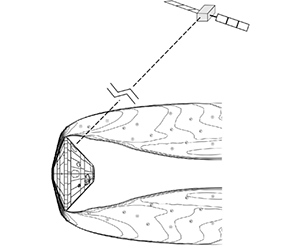Crossref Citations
This article has been cited by the following publications. This list is generated based on data provided by
Crossref.
Giangaspero, Vincent F.
Lani, Andrea
Poedts, Stefaan
Thoemel, Jan
and
Munafò, Alessandro
2021.
Radio communication blackout analysis of ExoMars re-entry mission using raytracing method.
Vandenhoeck, Ray
Lani, Andrea
and
Steelant, Johan
2022.
Development of an implicit high-order flux reconstruction solver for the Langtry-Menter Laminar-Turbulent Transition RANS model.
Computer Physics Communications,
Vol. 278,
Issue. ,
p.
108408.
Takahashi, Yusuke
Takasawa, Hideto
Yamada, Kazuhiko
and
Shimoda, Takayuki
2022.
Nonequilibrium shock layer in large-scale arc-heated wind tunnel.
Journal of Physics D: Applied Physics,
Vol. 55,
Issue. 23,
p.
235205.
Wu, You
Xu, Xu
Chen, Bing
and
Yang, Qingchun
2022.
Theoretical and numerical study of the binary scaling law for electron distribution in thermochemical non-equilibrium flows under extremely high Mach number.
Journal of Fluid Mechanics,
Vol. 940,
Issue. ,
Takahashi, Yusuke
2022.
Propagation Path of Radio Waves in Nonequilibrium Reentry Plasma Around a Nanosatellite With an Inflatable Aeroshell.
IEEE Transactions on Aerospace and Electronic Systems,
Vol. 58,
Issue. 5,
p.
4070.
Collen, Peter L.
Satchell, Matthew
di Mare, Luca
and
McGilvray, Matthew
2022.
Analysis of Shock Deceleration Effects on Radiation Experiments in the NASA Electric Arc Shock Tube.
Yang, Xinglian
Wang, Jingying
Zhou, Yue
and
Sun, Ke
2022.
Assessment of Radiative Heating for Hypersonic Earth Reentry Using Nongray Step Models.
Aerospace,
Vol. 9,
Issue. 4,
p.
219.
Collen, Peter L.
Di Mare, Luca
McGilvray, Matthew
and
Satchell, Matthew
2023.
Analysis of Shock Deceleration Effects in the NASA Electric Arc Shock Tube.
Journal of Thermophysics and Heat Transfer,
Vol. 37,
Issue. 2,
p.
503.
Giangaspero, Vincent F.
Sharma, Vatsalya
Laur, Johannes
Thoemel, Jan
Munafò, Alessandro
Lani, Andrea
and
Poedts, Stefaan
2023.
3D ray tracing solver for communication blackout analysis in atmospheric entry missions.
Computer Physics Communications,
Vol. 286,
Issue. ,
p.
108663.
Mathew, Bilji C.
Dutta, Prantik
Savale, Rushikesh R.
and
Thiley, Tenzing
2023.
Emerging Trends in Mechanical and Industrial Engineering.
p.
891.
Lani, Andrea
Sharma, Vatsalya
Giangaspero, Vincent F.
Poedts, Stefaan
Viladegut, Alan
Chazot, Olivier
Giacomelli, Jasmine
Oswald, Johannes
Behnke, Alexander
Pagan, Adam S.
Herdrich, Georg
Kim, Minkwan
Sandham, Neil D.
Donaldson, Nathan L.
Thoemel, Jan
Duncan, Juan C.M.
Laur, Johannes S.
Schlachter, Sonja I.
Gehring, Rainer
Dalban-Canassy, Matthieu
Tanchon, Julien
Große, Veit
Leyland, Pénélope
Casagrande, Angelo
La Rosa Betancourt, Manuel
Collier-Wright, Marcus
and
Bögel, Elias
2023.
A Magnetohydrodynamic enhanced entry system for space transportation: MEESST.
Journal of Space Safety Engineering,
Vol. 10,
Issue. 1,
p.
27.
Sharipov, Alexander S
and
Loukhovitski, Boris I
2023.
A simple semiempirical model for the static polarizability of ions.
Chinese Physics B,
Vol. 32,
Issue. 8,
p.
083301.
Alilou, Sima
Shahrassai, Laya
and
Sobhanian, Samad
2024.
Optimizing Spacecraft Re-entry Communication: Plasma Electron Depletion Through Controlled Particulate Injection and Fresnel Coefficients Analysis.
Brazilian Journal of Physics,
Vol. 54,
Issue. 5,
Laur, J. S.
Giangaspero, V. F.
Sharma, V.
Lani, A.
Donaldson, N.
Kim, M. K.
Giacomelli, J.
Herdrich, G.
Hein, A.
and
Thoemel, J.
2024.
Radio Communication Blackout Mitigation: Analyzing Magnetic Field Effects via Ray-Tracing Analysis.
AIAA Journal,
Vol. 62,
Issue. 6,
p.
2024.
Laur, Johannes S.
Giangaspero, Vincent F.
Lani, Andrea
Luis, Diana
Viladegut, Alan
Gonzales Rios, Jorge L.
Querol Borras, Jorge
Vasquez-Peralvo, Juan A.
Merlano Duncan, Juan C.
Hein, Andreas
and
Thoemel, Jan
2024.
Radio Communication Blackout Mitigation: A Three-Dimensional BlackOut RAy-Tracer (BORAT) with Signal Characterization for Magnetized Plasma.
Sharma, Vatsalya
Giangaspero, Vincent F.
Poedts, Stefaan
and
Lani, Andrea
2024.
Influence of magnetohydrodynamics configuration on aerothermodynamics during Martian reentry.
Physics of Fluids,
Vol. 36,
Issue. 3,
Kim, Chanho
Kim, Kyu Hong
Yang, Yosheph
and
Kim, Jae Gang
2024.
Effect of multi-temperature models on heat transfer and electron behavior in hypersonic flows.
Physics of Fluids,
Vol. 36,
Issue. 9,
Clarke, J.
Brody, S.
Steer, J.
McGilvray, M.
and
Di Mare, L.
2024.
Quasi-one-dimensional non-equilibrium method for shock tube and stagnation line flows.
Physics of Fluids,
Vol. 36,
Issue. 9,
Peng, Shunhao
Feng, Yongliang
and
Zheng, Xiaojing
2025.
Numerical study on plasma layer manipulation for blackout mitigation by pulsed magnetic field.
Aerospace Science and Technology,
Vol. 160,
Issue. ,
p.
110039.
Yang, LiMing
Li, Heng
Li, Kai
Yu, Yang
and
Jin, Ke
2025.
Numerical investigation on transport properties in nonequilibrium hypersonic flows.
Physics of Fluids,
Vol. 37,
Issue. 6,

 $\textrm {CO}_2$ flows is reviewed and one-dimensional stagnation line studies are performed in order to determine a suitable chemical mechanism for the electron density modelling. Hypersonic computational fluid dynamics (CFD) simulations are performed with a simplified chemical model including only neutral species, in order to calculate the flow field surrounding the ExoMars Schiapparelli module in flight conditions. A novel decoupled CFD approach is then applied where the calculation of the electron density is performed separately using a computationally inexpensive Lagrangian approach. Subsequently, a ray tracing algorithm is applied in order to model the propagation of electromagnetic waves in the wake flow past the ExoMars vehicle accounting for collisions between electrons and gas particles. The numerical results of the proposed novel approach for blackout analysis consisting of CFD, Lagrangian and ray tracing algorithms are in good agreement with the flight data.
$\textrm {CO}_2$ flows is reviewed and one-dimensional stagnation line studies are performed in order to determine a suitable chemical mechanism for the electron density modelling. Hypersonic computational fluid dynamics (CFD) simulations are performed with a simplified chemical model including only neutral species, in order to calculate the flow field surrounding the ExoMars Schiapparelli module in flight conditions. A novel decoupled CFD approach is then applied where the calculation of the electron density is performed separately using a computationally inexpensive Lagrangian approach. Subsequently, a ray tracing algorithm is applied in order to model the propagation of electromagnetic waves in the wake flow past the ExoMars vehicle accounting for collisions between electrons and gas particles. The numerical results of the proposed novel approach for blackout analysis consisting of CFD, Lagrangian and ray tracing algorithms are in good agreement with the flight data.

